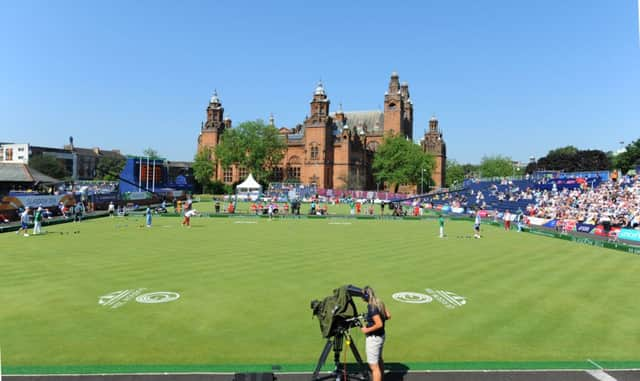Grandeur of Kelvingrove perfect setting for bowls


It was around 8:30am that the brightly coloured competitors took their places on the rinks in Kelvingrove Park for final practice. As the appointed time of 8:45am approached, an MC barked into a mic to ask the crowd if “everybody was ready for these Games to start”. A 60-second countdown followed, a big screen throwing up images of Sir Chris Hoy intoning that these could be “the best Commonwealth Games ever”, before the three, two, one gave way to a klaxon honk, and the jacks were sent down the manicured lawns playing host to 17 games simultaneously.
It was impossible not to be seduced by the scene. Here was Glasgow as the city would want to project itself. Glasgow as not only the dear green place, with the tented village of the venue sewn into the glorious treelined Kelvin Way, but Glasgow as a site of architectural splendour. The Victorian grandeur of the Kelvingrove art gallery and august spires of Glasgow University, one of the western world’s most ancient seats of learning, seeming almost to embroider the greens somehow. The genteel nature of lawn bowling and the age profile of its adherents often leaves it open to sneering, but its soothing rhythms seemed perfectly in keeping with the baking hot sunshine that enveloped the area.
Advertisement
Hide AdAdvertisement
Hide AdIt must be admitted most of the hardy lawn bowls enthusiasts in place for the first sessions would not have looked out of place sipping drinks in the Clansman with Jack and Victor. Indeed, there was something of the modern church congregation about them; in as much as young people weren’t wholly absent but notable by their rarity.
To the non-aficionados of a certain vintage, only the name Willie Wood would be conjured up if asked to name a Scottish Commonwealth bowler of repute. Wood, who enjoyed his zenith with double gold in the 1982 games, was fabled for sporting sideboards that you could sit wally dugs upon. In his heyday, he wasn’t what you would call svelte.
The current Scots male players don’t appear finely tuned athletic specimens either. There was, though, no doubting the finely-tuned abilities of skip Darren Burnett and his colleagues in the men’s triple team, David Peacock and Neil Speirs, as they blitzed India 27-6 to extend the perfect feel of the day for the host nation in the morning session.
The three gents had taken their place in the Scotland team the previous evening for the sparkling and sassy opening ceremony. That meant they only made it to their beds after midnight, before requiring to rise again at 6am. Yet, they had no quibbles over the unusual preparations. Quite the reverse in fact. “Going to the opening ceremony was a big help to us,” said Peacock. “The outstanding atmosphere really meant we woke up this morning still on a high and we carried that right into the game. We were in the groove immediately, and of course it helps if you have a couple of good shots early on, which we did.” The enthusiasm of the home crowd meant the Scots were never going to be sluggish. “We have played in front of crowds but nothing like this. It really is something different.”
The Commonwealth Games is something different, a place where sport is entwined with a global sense of communion. A powerful sense of that was provided in the rink next to the Scots where a women’s fours match featured Niue against Malaysia. Niue is apparently the smallest independent country in the world. A tiny island in the South Pacific situated almost 1,500 miles northeast of New Zealand it is home to only 1,200 inhabitants. Many of them, it seems, play bowls, including 21-year-old Jade Posimani, who wasn’t too down after her team lost to the Malaysians.
“It is an incredible adventure, very exciting,” she said. “I have not been abroad playing bowls before though I have been to Dubai. I have been blown away by the Games and Scotland. This is my first time in Scotland but I love it. It’s idyllic. I want to take my bowls career further now we have the resources at home to do so. There is only one green on the island but it is really popular.”
The Scottish progress was as serene as the weather yesterday. But the capacity for shocks was shown with the Jersey women’s fours beating the much-vaunted Australians, and Siti Zalina Ahmad, a double Commonwealth single champion, losing to Indian Nayanmoni. At these round-robin stages, no defeat is fatal, though.
For 25 years, the lilting Welsh tones of David Rhys Jones were heard on the BBC coverage of bowls. Pairs partner for David Bryant for almost 29 years before that, Jones is sensitive about the stuffy image and lazy stereotypes attached to bowls. The average age of the Australian team is younger than that of its cricket team, he points out. “The greens are probably about as good as at any Commonwealth Games since 1992,” he adds, “but it’s the setting of Kelvingrove and the sunshine that it’s been bathed in that could make the event special.”
Genuinely it was to be heard often yesterday, from spectators and volunteers, that “Glasgow has done us proud”. It was necessary to suspend all cynicism yesterday and heartily concur.